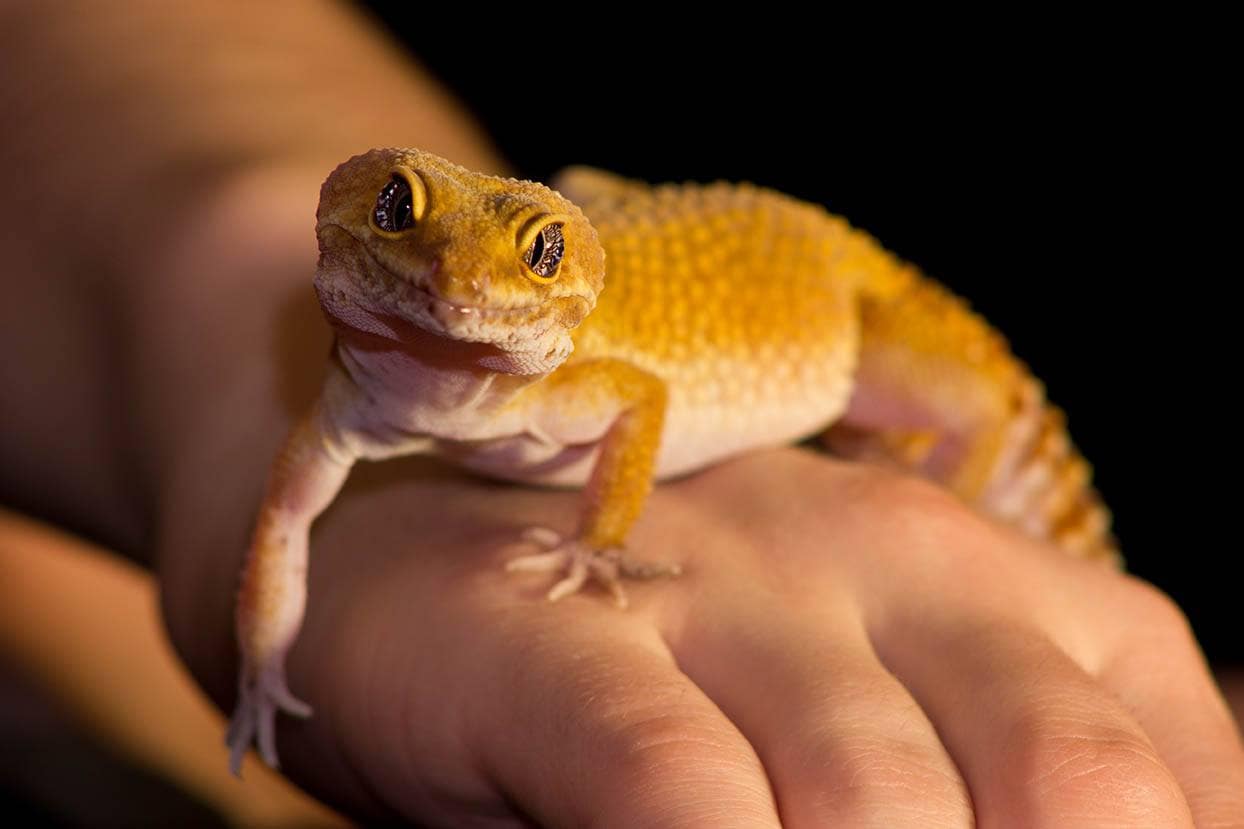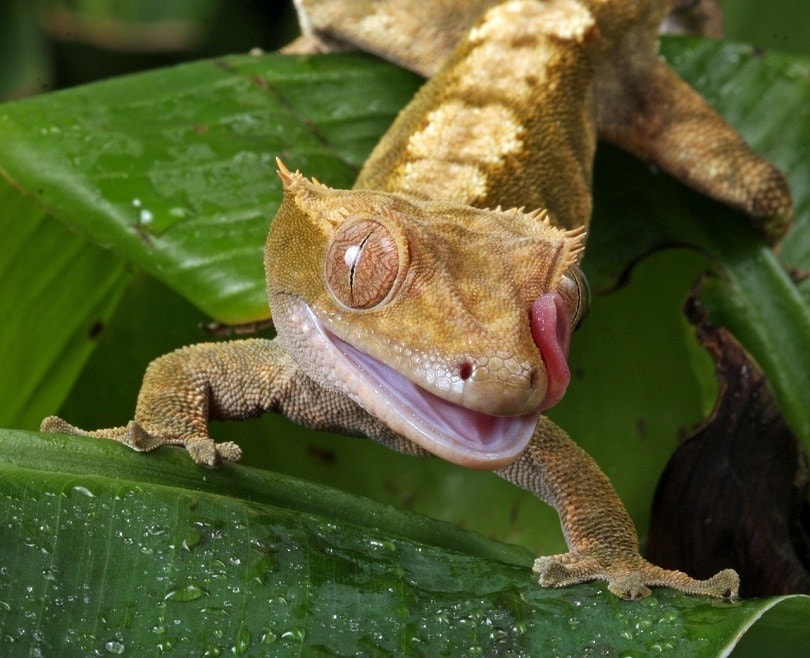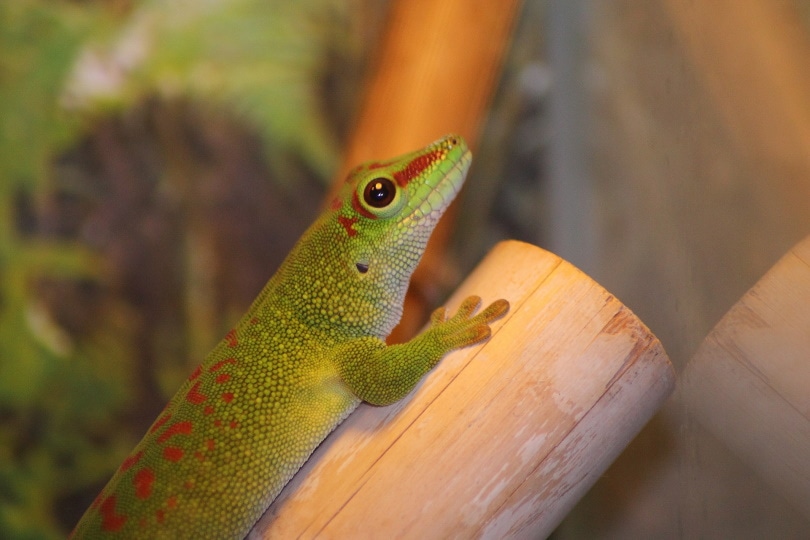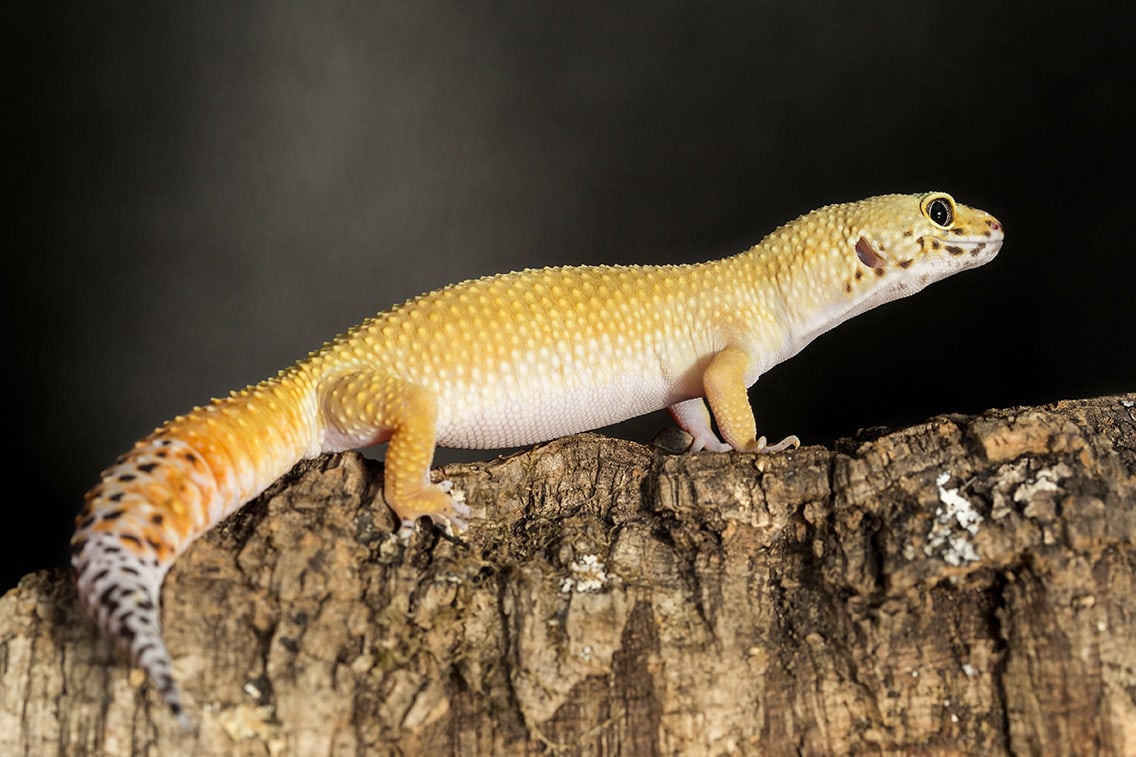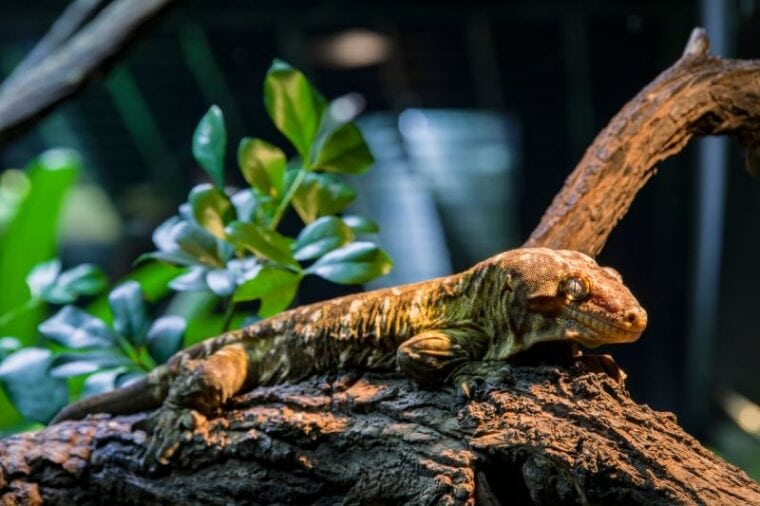
The Leachie Gecko is a species of Gecko that originates in New Caledonia. It is especially known for being the largest species of Gecko and for making vocal noises including barking and yipping. They have markings that mean they camouflage well against the bark of the trees in which they live. They are considered quite easy reptiles to care for, but new owners will need to ensure a suitable setup including adequate lighting and heating.
The Leachie will live up to 30 years in captivity, so taking one on does require a long-term commitment. However, they can be territorial and they are more expensive than a lot of other Gecko species.
Quick Facts about Leachie Geckos
| Species Name: | Leachianus Gecko |
| Common Name: | Leachie Gecko |
| Care Level: | Easy/Moderate |
| Lifespan: | 30 years |
| Adult Size: | 20 inches |
| Diet: | Insects and fruits |
| Minimum Tank Size: | 18 x 18 x 24 inches |
| Temperature & Humidity: | 72–82°F
60–80% |
Do Leachie Geckos Make Good Pets?

Leachie Geckos can make good pets. They are interesting and fun to watch and are bigger than other Geckos. However, not all Leachies like to be handled. You should start handling your new Gecko once it has had some time to settle into its new home, and because this species can be quite flighty, you will need to handle it carefully to ensure that it doesn’t get away. If you are looking for a pet that can be handled regularly, the Leachie might not be the best option, although there are many instances of Leachies enjoying human contact.
Appearance
The Leachie Gecko is the largest known of the Gecko species. It can measure up to 20 inches in length. They have thick bodies and stumpy tails, and they are patterned to look similar to tree bark and twigs, enabling them to blend into the background of the trees in which they live. There are different subspecies of the Leachie Gecko and the coloring can vary according to which subspecies you get. Colors can vary from green to gray and brown. You may even notice some colorful bands in some cases.
How to Take Care of Leachie Geckos
Leachie Geckos are arboreal. In the wild, they sleep in tree hollows, where it is warm and somewhat moist. When keeping them as pets, it is important that you try to replicate these conditions as much as possible. The size of the Leachie also demands a large setup, and because these are arboreal animals, they will need plenty of foliage and wood inside the tank.
Habitat, Tank Conditions & Setup
Leachie Geckos do have some specific requirements when it comes to an ideal setup.
Tank
The size of the Leachie means that it needs a larger tank than other Gecko species. 40 gallons is the minimum recommended tank size, and the tank should be at least 18 inches long, at least 18 inches wide, and at least 24 inches high. If you can provide more space, the reptile will benefit but a single one should be able to thrive in a tank of this size.
Lighting
There isn’t usually any need to provide UV lighting for a Leachie Gecko, unlike a lot of other reptile species. However, because this is a nocturnal species, do make sure that lights are turned off at night or that the enclosure is covered.
Heating
Heating is important, and it is good practice to offer a gradient of heat across the length of the tank. Most of the enclosure should be at around 75°F but you can create a basking area up to 82°F. If the temperature in the enclosure drops below 70°F, especially at night, you will need to install a heat source of some sort.
Humidity is another important consideration. Buy a hygrometer and keep it in the tank so that you can easily see the display. Leachies need their enclosure to have a humidity level between 60% and 80%. This will likely mean having to mist inside the tank every other day but do ensure that the humidity level does not go above 80%.
Substrate
Leachie Geckos live around trees and in areas with soil, so you should replicate this on the ground of the enclosure. Soil is a good choice because it will enable you to add real plants to the enclosure, but this does not mean that you will need to ensure good drainage from the bottom of the tank.
| Tank Recommendations | |
| Tank Type | 40-gallon glass vivarium |
| Lighting | N/A |
| Heating | Heating pad/tape on bottom of enclosure |
| Best Substrate | Soil |
Feeding Your Leachie Gecko
In the wild, Leachie Geckos are omnivores and would typically eat a combination of insects and fruit. You can attempt to replicate this diet by giving live insects and fruit, or you can feed a commercial Gecko diet, and supplement this with insect treats. Waxworms, roaches, and crickets are popular insect foods. Insects should be gut loaded before feeding, which means feeding the insects a calcium-rich diet that the Gecko will digest when eating the insect. You should also dust the insects with a calcium supplement to maintain good calcium levels for your reptile.
| Diet Summary | |
| Fruits | 50% of diet |
| Insects | 50% of diet |
| Meat | 0% of diet |
| Supplements Required | Calcium |
Keeping Your Leachie Gecko Healthy
Always ensure that temperature and humidity levels in your Leachie’s enclosure are suitable. Invest in a heat mat, if you need to get temperatures up, and use a hygrometer to determine accurate humidity levels, rather than trying to guess.
Some of the most common health problems for Leachie Geckos are those caused by poor enclosure or feeding standards. Bacterial and viral infections are common in reptiles if their enclosures are too wet. Calcium deficiency can occur if insects are not gut-loaded and dusted before feeding.
Lifespan
By providing optimal conditions and diet, you can help prolong the life of your Leachie Gecko. Those living in captivity, as pets, can live as long as 30 years, which makes them great pets. Although most will only live around 20 years.
Breeding
Leachie Geckos can be kept together as a breeding pair. They have fewer clutches, and fewer eggs per clutch, than a lot of lizard species, so you shouldn’t become inundated with little lizard feet. Wait until the lizards are at least 3 years old and have reached their full adult size before breeding, or the female can struggle to lay her eggs and may become egg-bound.
After mating, the first clutch will usually be laid in approximately 30 days. It is common for Leachies to have two or three clutches, but they can have as many as six. Each clutch usually consists of just two eggs. It can take several months for the eggs to hatch, with typical times ranging from 2 months to 4 months. Keep the temperature between 60°F and 80°F and bear in mind that the warmer the incubation temperature, the greater the likelihood of the resulting young being male.
Are Leachie Geckos Friendly? Our Handling Advice
When in their enclosure and free from stress, Leachies are docile reptiles. And as long as you handle them regularly and from a young age, yours may tolerate being handled. However, this certainly isn’t true of all of them. Some will become stressed and may strongly dislike being handled. Some can also be very territorial and may growl or attempt to nip anything that approaches their enclosure. As such, owners are typically advised to proceed as though the Leachie Gecko does not like to be handled and to enjoy the appearance and unique characteristics of this reptile from afar.
Shedding & Brumation: What to Expect
Like most lizards, Leachie Geckos will shed their skin as they grow and as the skin becomes damaged through injury, illness, or general wear and tear. When the lizard is young, it grows much more quickly, which means that it needs to shed its skin more often, too. You can expect a young Leachie to shed every few weeks to every couple of months. Once it reaches adulthood, the frequency of shedding should slow down so that it only sheds once or twice a year. As long as the enclosure is kept at the right humidity, the Leachie doesn’t usually have any problems shedding.
How Much Do Leachie Geckos Cost?
Leachie Geckos have comparatively few eggs, at least compared to most other reptiles, and this means that their price can seem high. Expect to pay between $500 and $1,000 for a young Leachie.
Care Guide Summary
Conclusion
The Leachie Gecko isn’t the most commonly kept pet Gecko. It has somewhat plain markings, compared to other Geckos, often doesn’t relish being handled, needs a large enclosure, and costs quite a lot for a reptile. However, it is the largest of the Gecko species, and as well as being fascinating to watch, it also makes unusual vocalizations that keep owners entertained. They are also considered relatively easy to care for.
Featured Image Credit: Danny Ye, Shutterstock



